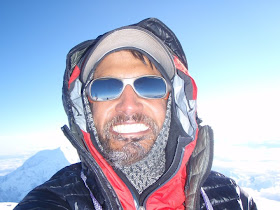 |
| The author, rocking out his Spectron 4 shades in the bright light on Denali |
This leaves you with a bit of a dilemma, seeing as sunglasses generally are made for when the sun is out, right? Most sunglasses are just too dark to use when the clouds are out, making visibility even a bigger issue. Julbo USA realizes this issue, and as such have created glacier glasses with much higher visible light transmission. They use a lens system which range from Spectron 1 - 4, with the higher number eliminating more of the visible light. They have even created a lens system, which they call Camel, that is photochromatic - meaning it transitions between two different lens categories depending on the amount of light available.
This feature however, can price some people out of these glasses, and personally, I choose another option anyway. On long expeditions, I will bring 3 different sets of eye wear, for a variety of reason. The first, is a pair of sunglasses that have Spectron 4 lenses, for those days that are bluebird and the sun is out shining. The second pair, will have Spectron 3 lenses in it, and an anti-fog coating. I tend to find that when I'm in a white out, there is a lot more heat and moisture and my glasses will fog up. That is why it is most important to have an anti-fog coating on this pair.
 |
| The author, with his Spectron 3 glasses - preparing for when that fog rolls in. |
My final pair, will be some goggles, with the highest visible light transmission possible. If I have goggles on, it is probably because the weather is so terrible and the wind is blowing so hard, that I will need to be able to see as much as possible. Smith Optics makes a great pair of lenses called the sensor mirror, which seem to increase contrast and really help with the flat light that can be found in a blizzard.
 |
| Smith goggles with the Sensor Mirror Lens. |
The important thing to note, is that all of these glasses/lenses filter out 100% of UVA/UVB rays. The amount of visible light that is transmitted is a completely different story, which is why you can still remain protected while altering your lens to the current conditions. Additionally, you could very well get a pair of glasses with Spectron 3 lenses, and they would serve most all of your purposes. I choose 3 pairs of eye protection because I like to have redundancy in this system. If I, or someone else on my team, loses or breaks their glasses - there will be a back up pair. I would rather carry the extra weight of a second pair of glasses, than go snow blind.
 |
| The author, covering up his skin and rocking a different pair of shades on the summit of Denali. |
Let's not forget the most important reason to carry more than one pair of sunglasses however. Sometimes it's nice to switch up your style while on the mountain!
--Andrew Yasso
Program & Expedition Coordinator
Seriously! The three tenets of mountaineering are 1) Fashion, 2) Safety, 3) Fashion.
ReplyDelete@Anonymous
ReplyDeleteIf you like fashion, and mountaineering - you may like this fashion show!
http://racked.com/archives/2011/02/14/nhoolywoods-windclapped-turn-of-the-century-climber-collection.php
Nice article, I generally take three pairs too. Julbo cat 4 glasses, Julbo cat 4-2 goggles and a pair of oakleys for town/walk-in & cloudy conditions.
ReplyDeleteWhat are your thoughts on polarized sunglasses?
ReplyDeleteI love them because they take away the glare off reflective surfaces, but they aren't very dark, which is great for lower light situations, but they are great for full-sun applications too because they take away that glare.
"What are your thoughts on polarized sunglasses?"
ReplyDeletePersonally, I'm not a fan of polarized glasses except on water. I prefer to see the glare of ice when in the mountains (whether it's climbing or skiing). Polarization also filters the glare of glass and debris on the road while cycling, but that's another topic...
I don't really have specific thoughts on polarized sunglasses, seeing as I don't have a lot of experience with them on a glacier.
ReplyDeleteI don't tend to notice/be bothered by the glare on glaciers however, so I think that is why I have never bothered using a polarized pair.
-Andrew